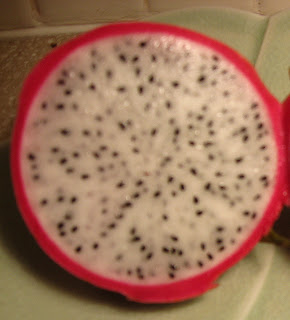Being the curious soul that I am...I had to try these fruits with the gorgeous color. They are huǒ lóng guǒ 火龍果/火龙果 "fire dragon fruit" or lóng zhū guǒ "dragon pearl fruit" to you if you are Chinese, thanh long "green dragon" if you are Vietnamese, and pitahaya if you are Mexican. If you are a scientist you probably call them the fruit of Hylocereus undatus.
There is a legend that a dragon was breathing fire, and at the end of the fire, out came dragon fruit. I guess this is how it was given its name.
They actually grow on cacti which are native to Central America. Our first evidence of them being used as food comes from the Aztecs of the 13th century.
In the 1830s, some plants, including pitahaya, were loaded onto a ship bound for Canton, China at a Mexican port. Many of the plants died, so they were discarded during a stop-over in Hawaii. The captain noticed that the pitahaya was still alive, so he planted a cutting. Since Hawaii has such a perfect climate for the pitahaya, the plant spread and became one of the most common ornamental plants.
These cacti grow quickly, are easily cultivated, and thrive in moist, tropical climates. The flowers open at night, therefore the main pollinators are bats and moths.
They are quite commonly grown in Vietnam and Malaysia. They are the largest fruit export of Vietnam.
These fruits have many valuable food qualities. They have many antioxidants and are said to help people lose weight. They also have a lot of vitamin C and dietary fiber.
Some dragon fruits have pink flesh, but the ones I tried have white flesh. The black seeds are throughout the fruit and can be eaten along with the flesh. The only part that is not edible is the tough outer covering.
Dragon fruits have a mild taste, reminiscent of kiwi fruits. They are now commonly mixed with other flavors in popular drinks. They are excellent when eaten raw.
An interesting fact about Hylocereus is that it is used as a base for grafting other cacti. This produces the colorful cacti that you can buy in many stores in the United States. For further information about this you can read http://plantsarethestrangestpeople.blogspot.com/2008/01/unsung-hero-hylocereus-undatus.html.
For further information about the plant in general, go to http://www.hort.purdue.edu/newcrop/morton/strawberry_pear_ars.html.


No comments:
Post a Comment